- search Close
- Press Enter

- Our new site uses your password recovery email address as the login name. Simply click 'Forgot Password?' and enter your email. If you get a notice to change your password you are all set! If not try another email, create a new account or please contact us and we can update your email.
- Forgot Password?

Guidelines for 650B Conversions
by Ed 650Braley • July 03, 2023
Originally Published May 5, 2007
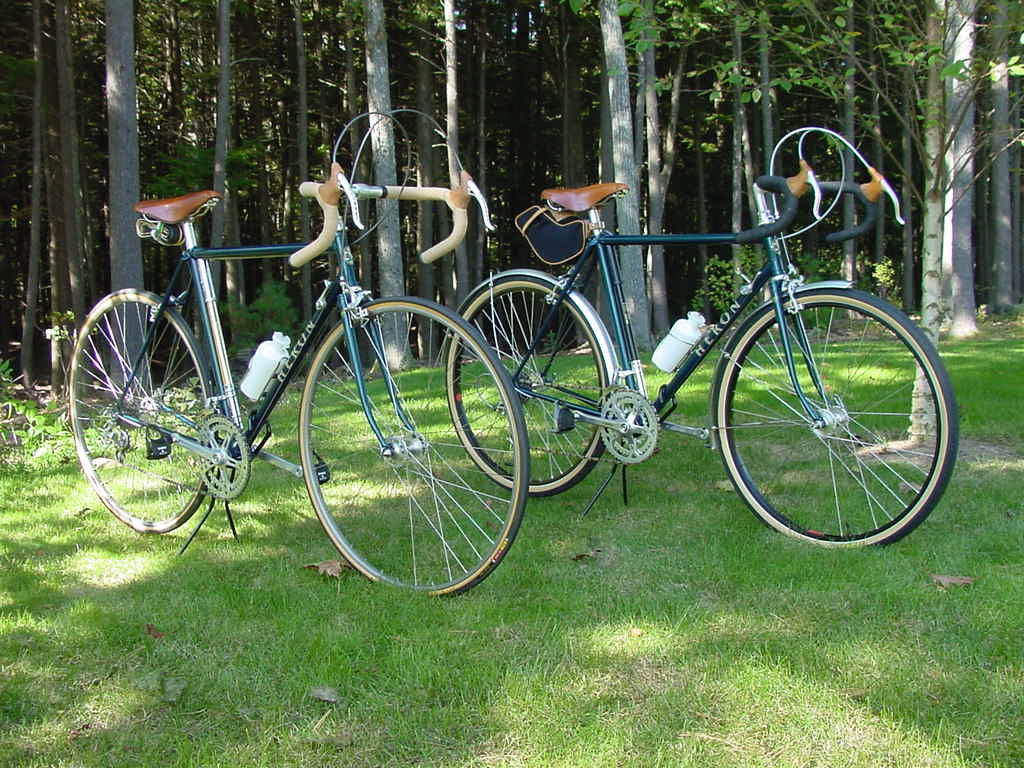
In the last few 650Blog articles I've introduced the 650B wheel and shown a few bikes configured with them. Perhaps now you're curious, and thinking about cycling from a different perspective. Maybe you're wondering about that dirt road that you've always passed-by, or that alluring gravel path that runs down by the river... maybe you'd just like to explore some new roads and keep right on going, whatever the weather or surface conditions become. You're thinking about having your own 650B experience. But you aren't yet ready to buy a new 650B specific frame and build it up. Well Dear Reader, this article is for you.
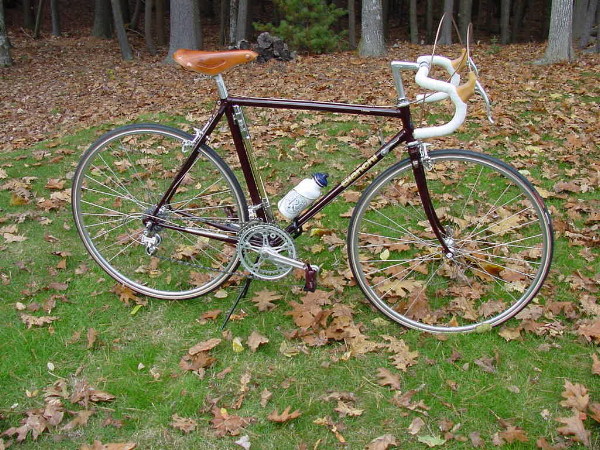
As I've mentioned previously, there are literally thousands of nice older road bikes that can be converted to roll on 650B wheels. And this is what makes it possible for you to try this wheel format without having to buy a whole new 650B bike or frame. Provided that a few of the frame dimensions are within range, it's possible to convert many 700C, and even some 27 inch wheeled bicycles, to 650B. And a 650B converted bike can be amazingly good! In many cases the resultant 650B bicycle is actually superior to the previous configuration with the bigger wheels. Sometimes they come together in such a way as to make you wonder if they weren't actually planned to be 650B machines. As a recap, you'll recall that the overall diameter of a 650x38B wheel is very close to that of a standard 700C wheel with a 23mm tire. So, when you do a conversion, you're decreasing the rim diameter a bit and making up most of the difference by using a bigger tire.

Then the space remaining provides enough room to fit practical fenders. Due to the fact that the rotating mass of the rim and tire bead is a little closer to the axle, the wheel still accelerates quickly, even with this bigger tire. So your newly converted 650B bike still handles beautifully, it accelerates quickly, and it can go places where it would never be comfortable or safe to ride on the skinny tires. It's a phenomenal transformation!
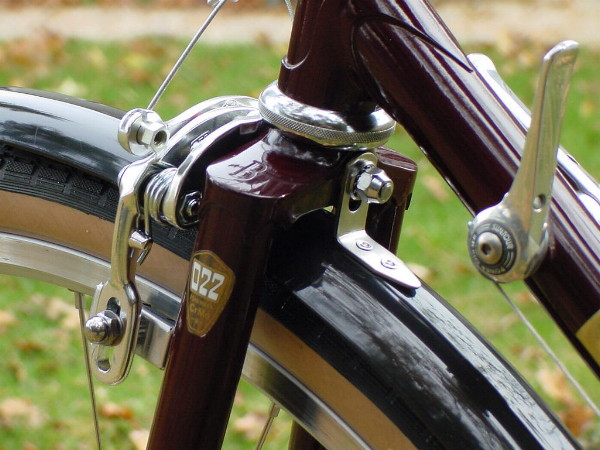
What do you look for in a bike that you want to convert to 650B?
Frequently I'm contacted by people who are ready to try their own 650B conversion, and I usually reply with a list of criteria and considerations to help them determine if the project should be pursued. In this edition of the 650Blog, I'll provide a summary of the critical attributes and other things to consider when contemplating a 650B conversion project. First off, let me say that in general, the lugged steel framed Japanese sport-touring bikes of the early eighties are some of the best candidates. They're well made, are very common, and can be a great value. Models with 700C wheels, short-reach sidepull caliper brakes, fender eyelets, and real fork crowns have the right basic attributes for conversion. These bikes were imported in large quantities, and many of them sat unused for many years as the mountain bike boom captured the majority of the attention in the sport of cycling. There are many good 650B conversion candidates from other countries and market segments, too. Several people have successfully converted American and European racing and touring bikes to 650B. However, bikes that have cantilever brakes are not viable candidates for 650B conversion due to the fixed placement of the canti bosses. The bosses will be right next to the 650B rim and proper brake adjustment is not possible without relocating these brazed-on fittings. Whatever the make, model, or type of bike, it has to meet a few simple criteria to be most easily converted to 650B. Now, let's narrow it down further. There are three critical frame issues that need to be surveyed on any prospective 650B conversion candidate: tire clearance, brake reach, and bottom bracket height. A metal tape measure with a metric scale is all you need for this job.

Tire Clearance
The unique charm of 650B wheeled bicycles is the sensation of riding on big puffy lightweight tires that absorb road shock, handle loose surfaces, and still accelerate quickly. The best 650B conversion bicycles will accommodate a range of tires from 32mm to 38mm wide. Your frame will need clearance for these bigger tires. The widest part of a 650x38B tire is located 320mm from the axle center.

Most of the 38mm tires actually measure somewhere between 34mm and 37mm when inflated to 50psi, so I recommend tire clearance of no less than 42mm. You will need to measure for this clearance at a distance of 320mm from the axle center in the areas under the fork crown, between the seat stays and between the chainstays. You can run the narrower 650B tires in a bike which has less than the recommended 42mm clearance, but the narrow tires can create another problem that I'll explain a little further on.

Brake Reach
You will almost certainly need to change the existing brakes on your bike for a 700C to 650B conversion because the difference in rim size is greater than the range of adjustment provided by most brakes. The 650B rim has a bead seat diameter of 584mm, whereas the 700C rim is 622mm, and the 27inch rim is larger still at 630mm. If you convert from 700C to 650B the brakes will need to adjust downward half of that 38mm difference, or another 19mm. A 27inch to 650B conversion will require an additional 23mm of brake reach. So, you can look at the brakes on your bike and measure the distance from the center of the brake mounting hole to the center of the rim to get a base number. Then, add the increase to determine the new brake reach. A brake reach requirement somewhere between 58mm and 75mm will allow you to fit readily available brakes to your 650B converted bike. For example, if your bike has 700C wheels and short reach brakes with the pads set at mid-slot, which is 44mm, then the new reach requirement will be 44mm + 19mm = 63mm.

There are a few caliper brake options from which to choose when configuring a bike for 650B conversion. But the most common are the old centerpull style caliper and the modern extra long reach dual-pivot caliper brake. There are other obscure, unusual, and rare brakes that can be used, but that's a subject beyond the scope of this article.

The new Tektro R556 dual pivot brake that I recently reviewed for Bikeman is the best current production caliper available for 650B conversions. It's a fantastic brake. However, it is only supplied with mounting bolts for recessed allen nuts. If your bike uses this type of brake attachment and has a reach requirement in the 55mm to 73mm range, then you're in luck. If your bike uses external hex nuts for brake attachments, it may be possible to drill out the back side of the fork crown for a recessed mounted front brake. If the rear brake bridge has a cast tunnel for brake mounting, it may be possible to drill that out and use a recessed allen nut there too. Sometimes it's possible to drill the backside of the fork crown and use the rear brake with a long problem solvers type recessed allen nut in the front, and then attach the front brake with a hex nut on its longer bolt on the brake bridge in the rear position. And of course you'll want to use the proper radiused washers to fit the profile of the round tubes if that's the interface for the brake mount. Most shops can supply these bits if you need them. But let's assume that you're not quite ready to take the drill to your bike. In this case you'll need hex nutted brakes that will go the distance for the new reach requirement. The old centerpull calipers are typically used in this situation. Centerpull brakes were commonly available in 65mm and 75mm reach models, and most of the 650B conversions will require the longer 75mm model. Centerpull calipers will also require cable hangers, so you will need to retrofit a hanger in the headset stack, or somewhere on the stem in front. A corresponding cable hanger will need to be attached somewhere on the seat post binder or thereabouts for the rear brake. Again, your local shop can be a source for these items, and Bikeman offers many of them in the online store as well.

Bottom Bracket Height
The bottom bracket height is the distance from the center of the crank spindle to the floor, measured when the bike is standing upright on a level surface. The frame designer sets a target bottom bracket height which he considers to be reasonably safe in order to avoid pedal strike when the bicycle is pedaled around corners. Because if you strike a pedal hard while cornering, the rear wheel will un-weight, and you'll crash. Needless to say, this is to be avoided! So the frame designer considers the tire size, crank length, and type of pedals he'll configure on the finished bicycle, and specifies a frame dimension which will yield the desired bottom bracket height with the chosen tires. The frame dimension which the designer specifies is called bottom bracket drop, it's the distance below the axle centerline to the bottom bracket centerline. If you have the geometry tables for your bike, look for a drop figure between 65mm and 72mm. But unless you have the frame geometry tables, you'll need to work with the height that you can measure directly on your bike. The bottom bracket will come down a bit with 650B tires, you can expect a lowering of about 8mm-10mm converting from 700x23mm tires to 650x38B tires. For reference, the old racing standard for bottom bracket height is 267mm, and that was determined when people rode toe clips and straps on 170mm cranks. It's still a good guideline. So a good 650B conversion candidate will have a bottom bracket height of about 275mm with 23mm 700C tires. More is better, but anything lower than 270 is risky.

I usually ride narrow or low Q factor cranksets with 170mm arms, and I ride clipless pedals. Most of my own bikes have bottom bracket heights between 260mm and 268mm after 650B conversion, and that's in the ideal range for me. If you run longer crank arms, cranksets which have a wide Q factor, or use big wide pedals, then you'll have an increased likelihood of pedal strike if you lean it over while pedaling, so take that into consideration. Some people will solve tire clearance issues by fitting smaller tires, but this works against the preservation of bottom bracket height. And again, to get the maximum 650B effect you really want to run those nice puffy 650x38B tires at 40-50psi anyway, so keep that in mind when you survey your 650B conversion candidate. If all of these dimensional criteria are met, the final thing that I look for in a 650B conversion candidate is the provision to mount fenders. Riding in the rain, on gravel roads and over dirt paths is fun and it's part of the 650B experience. Having full fenders to keep the spray off of your bike and off yourself just makes that all the better. So I like to have fender eyelets front and rear, and a chainstay bridge for anchoring the rear fender is also good to have. But the absence of fender fitments isn't a show stopper, you can still attach the fender stays with p-clips and use zip ties where necessary. That's it!

Although I've given you a fairly specific list of parameters, it's amazing how many bicycles were built which meet them. There were literally millions of road bikes built in the period from the late seventies through the early nineties, and a large percentage of these nice older bikes make excellent 650B conversions. You may already have a suitable older bike that you haven't been riding much lately, or there could be one available locally, and you can frequently find them on eBay. With the information that I've provided in this article you can now probably look at pictures of bikes and have a pretty good sense for the viability of converting them to 650B wheels.
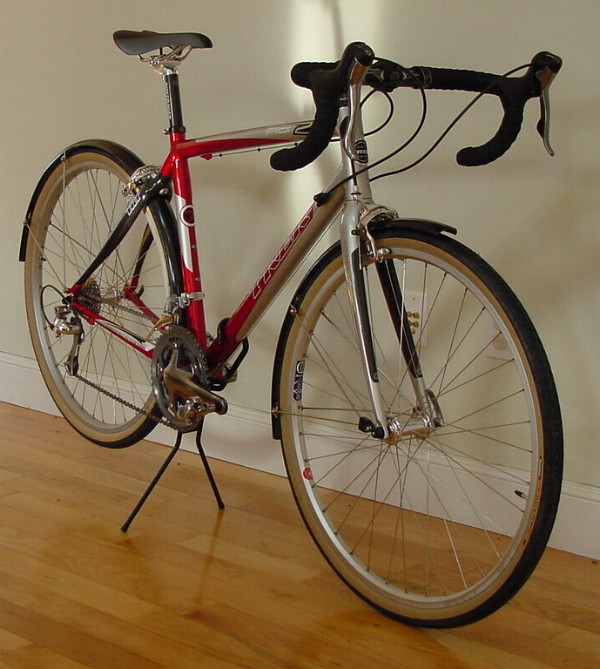
Remember, converting a suitable bike to 650B is a no-risk proposition because you're not making any permanent modifications to the bike. If you try the conversion and decide that you're not happy with the bike afterwards, you can simply put it back to 700C. And then you can try the wheels and brakes on another bike. I've done that, but most of the bikes that I've converted remain configured with 650B wheels because I've been very pleased with the results. With a suitable used road bike, a 650B wheelset, a brakeset, and some fenders, you could assemble a versatile, comfortable, and fun machine that may become one of your favorite bikes. You'll ride it fast, and you'll ride it slowly. You'll cruise along over those dirt roads, gravel paths, and broken roadways, - and you'll be hooked on the 650B experience. Try it!
Ed 650Braley
- Search Submit
650Blog News Product Info Race Reports Rider Profiles Tech Info The Attic blog home
Recent Posts
Back In the Saddle Again Season Opener Kilowatt Cross Lutsen 99er Canadian Rockies What a Lousy Summer Vermont Mountain Biking Titcomb Mountain Challenge 2024 Carrabassett Backcountry Cycle Challenge 50k Carrabassett Backcountry Cycle Challenge 100k Final de Barro 2024 Fall 23 & Winter 24 update... Iceman Cometh 2023 SoCal Cross Power Outage at Bikeman Headquarters Peak2Peak Moran 66 PBC Glen Park Enduro Gravel Riding in the Sawtooths of Idaho And…we’re back Greylock Goaround The Hibernator Attic What IZIT #18 Attic What IZIT #17 Name That TOOL #15 Attic What IZIT #16 Name That TOOL #14 Attic What IZIT #15 Name That TOOL #13 Bike Doctor Sheduro
September, 2024 August, 2024 July, 2024 May, 2024 March, 2024 February, 2024 January, 2024 December, 2023 November, 2023 more archive dates archive article list
© 2024 Bikeman. All Rights Reserved. Powered by Miva

650b Conversion - Trek 613b (1982)
Joseph Kopera
Nick Favicchio
A rather light tweek to the front fork should get you into upper 30 trail territory and it looks like you've got loads of room at the fork crown. And I'd not be shy about dimpling the chainstays. But that's me :).
Joey Kopera
Andrew Patteson

Tony DeFilippo
I've got another 600 series that is just my size waiting for a similar project. Congrats and enjoy the ride!
Peter Latner
-- You received this message because you are subscribed to a topic in the Google Groups "650b" group. To unsubscribe from this topic, visit https://groups.google.com/d/topic/650b/ySj8bsMItGM/unsubscribe . To unsubscribe from this group and all its topics, send an email to [email protected] . To post to this group, send email to [email protected] . Visit this group at https://groups.google.com/group/650b . For more options, visit https://groups.google.com/d/optout .
You received this message because you are subscribed to the Google Groups "650b" group. To unsubscribe from this group and stop receiving emails from it, send an email to [email protected] .
Nice conversion! Makes me wish I hadn't sold that 614 years ago... But, that was before 650B had returned to the scene. Nice photos on your flickr account, Joe. I really enjoyed looking through them the other evening! Ed.
Thanks, Joe.
[email protected]
SORT CONTENT BY LOCATION
CLICK TO DRILL DOWN BY COUNTRY/PROVINCE
Your browser is ancient! Upgrade to a different browser or install Google Chrome Frame to experience this site.
Inspiration
- Bikepacking 101
- Join/Support

- View Latest/All
- Bikepacking Videos
- Your Stories
- Rider's Lens
- Field Trips
Popular Tags
- #bikerafting
- #Tour-Divide
- #family-bikepacking
- #winter-bikepacking
- #1Q5V (1 Question 5 Voices)
Gear/Reviews
- Bikepacking Bags
- Camping Gear
- Accessories
- #Editors-Dozen (Our Favorite Gear)
- #Gear-of-the-Year
- #MYOBG (DIY)
- #Decade-in-Review (Best of All Time)
The Gear Index
Latest indexes.
- Mini Panniers
- Saddlebags & Top Openers
- Cargo Cages & Anything Bags
- Gravel Bars
- Drop Bar 29ers
Bikepacking Bikes
- Rigid & Plus Bikes
- Drop-bar & Gravel
- Full Suspension
Rigs & Roundups
- Rider & Rig
- Race/Event Rig Roundups
- Worthy Builds
- Handbuilt Bikes
- #29+ (29-plus)
- #vintage-mountain-bikes
- #cargo-bikes
- Readers' Rigs (Dispatch)
- New Bikes (Dispatch)
Plan Your Trip
Bikepacking guides.
- Bikepacking Food
- Gear & Pack Lists
- Bike Photography
Essential Reading
- Leave No Trace (for Bikepackers)
- Guide To Bikepacking Bags
- Bikepacking Gear That Lasts
- #Bikepacking-Awards
- Power Of An Overnighter
- Advice For New Bikepackers
- Our Favorite Bikepacking Routes
-
Where to Begin
We have over 300 original and curated bikepacking routes in our global network spanning nearly 50 countries.

Start at our worldwide routes map to dig into our detailed guides with GPS maps and inspiring photography.
By Location
- The United States
- Latin America
- Middle East
By Length (days)
- Overnighters & S24O
- Weekend Routes (2-4)
- Week-long Routes (5-10)
- Odyssey Routes (11-30)
- "Freakouts" (31+)
Local Overnighters
The Local Overnighters Project is a unified effort to document and map one-night bikepacking routes all over the world—by locals, in their own backyards.
The Bikepacking Journal is our biannual printed publication. Each issue features a collection of inspiring writing and beautiful photography. Find details on the three most recent issues below, join the Bikepacking Collective to get it in the mail (anywhere in the world), or click here to find a collection of selected stories in digital format.

For Issue 11, we head to Iceland with two contributors and photographers, plus share a handful of brilliant adventures from Mexico, Spain, the Republic of Georgia, and riders' own backyards...

The special edition 10th issue of The Bikepacking Journal is one you won’t want to miss! It features 25% more pages with extra stories, bonus art and maps, and much more...

Issue 09 takes readers on trips through time—one to the early days of bicycles—and offers several reminders to be grateful for supportive friends and family, and strangers we meet along the way...


700C to 650B: Road Bike to Dirt and Gravel Rig

By Logan Watts
Founding Editor & Routes Director
2,110 Posts
Interested in converting a 700C cyclocross or touring bike into a 650B gravel bikepacking rig? Or maybe you’re just intrigued by 650B / road plus? With the promise of dirt-friendly tires and a more supple ride, there’s plenty to like. We took an Advocate Lorax and made the switch. Find out what we learned about 650B, everything you need to know about such a conversion, and details about the specific components we selected.
PUBLISHED Apr 26, 2018
With the recent flood of 650B gravel/adventure bikes coming to market, and 47-50mm road plus tires surging in popularity, you might be interested in purchasing a new 650B rig or converting the 700C bike you already have. Otherwise, you might just be trying to wade through all the marketing jargon to see if 650B is a good fit for you. In this guide, you’ll find all the facts and figures you need to know about 650B, learn whether your 700C bike is suitable for a conversion, and get some ideas about how to take on such a project. First, let’s start with the basics.

What is 650B?
In short, it’s a wheel size in between 26” and 29”. To clarify, there are three commonly used wheel sizes in the conventional bike market—26”, 27.5”, and 29”—that are based on 559, 584, and 622mm bead seat diameters, respectively. Just as a 700C wheel is the same diameter as a 29” (29er) wheel, 650B shares the exact same rim diameter as 27.5”.
As it happened, the bike industry came to describe and market road category (drop-bar) products in “C” and millimeters, and mountain bike products in inches. Well, kind of. It’s not an altogether exact science, since the 700 and 650 numbers don’t translate. 27.5”/650B rims have a bead seat diameter of 584mm, and 29”/700C rims have a bead seat diameter of 622mm. Adding to the confusion, and counter to what the industry might lead you to believe, 650B is nothing new. It’s actually been around for quite some time (see boxout below).
A Brief History of Tire Sizes
Why are rims with a 622mm bead seat called 700C and ones with a 584mm bead seat called 650B? Originally, there were 700A, 700B, and 700C rims and tires, all of which had an outer tire diameter of 700mm, with A being the skinniest (and fastest) and C tires being the thickest. So, A had the largest rim (bead seat) and C had the smallest. Eventually, the C permutation won out, and people altered the outer diameter by mounting different tire sizes on a 700C rim.
A similar scene played out with 650 rims. There were several variations on the rim diameter and ‘B’ triumphed, although Schwinn adopted 650C for their cruiser bikes for a while. Back in the 1930s, the “650B Balloon,” also known as 26 x 1 1/2″, became popular in France for randonneurs, loaded touring bikes, and tandems. However, the 650B size never caught on in the United States, and its popularity waned in France alongside the growth and adoption of the mountain bike.
Much later, circa 2007, with Kirk Pacenti on the front lines, 27.5” mountain bike wheels suddenly hit the scene. Years after, in 2013, it took off when almost a dozen bike companies released 27.5” mountain bikes touted to have the perfect blend of a 29er’s rollover with the nimble playfulness of a classic 26” wheel. Parts manufacturers followed suit. Today, 27.5” wheels have all but taken over.
All the while, in the expanding all-road and gravel scene, there has been a dedicated 650B fanbase who have been diligently working to restore it to its former glory. Driven by aficionados of the classic French style bikes and gravel brevet enthusiasts, tire options started popping up. With new 650B bikes popping up monthly, now seems to be its time.
Most of the bikes now coming out in this genre are either road plus / all-road, or more of an aggressive monstercross style. The latter usually means 27.5 x 2.1” semi-slick tires or bigger XC rubber, like the WTB Nano on the Bombtrack Hook EXT-C. And road plus often refers to 47-50mm tires that are generally devoid of tread aside from small side knobs, like the WTB Byway, or have a slight texture like the tire that started it all, the Compass Switchback Hill 48mm.
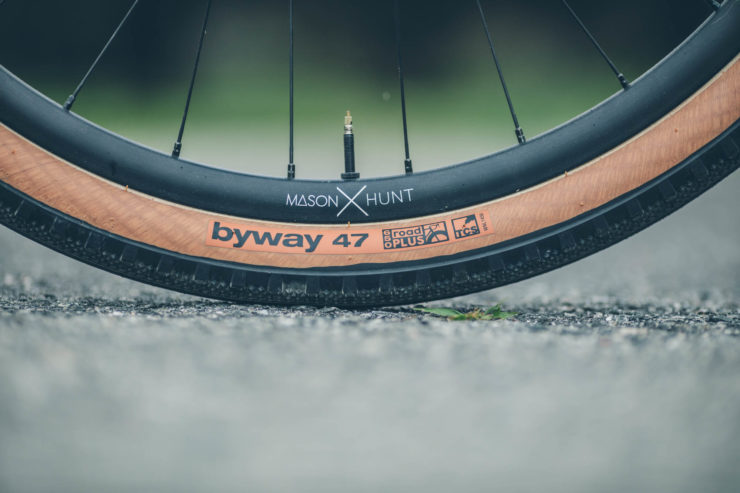
Appropriately, the Switchback Hill was named after a pass on the 360-mile Oregon Outback gravel route, where the gravel is quite loose. The Switchback Hill was developed as an all-roads tire to add floatation and provide speed and security when the going gets rough. In addition, 30% of the Oregon Outback route is on pavement, so this tire style is meant to roll as fast and grip as well as a good road tire would, offering of the best of both worlds. We asked Jan Heine, 650B connoisseur and founder of Compass Bicycle, how he decided on the Switchback Hill’s 48mm width, a size many other companies are now following.
According to Jan, “We were thinking about how wide a tire can fit between a set of ‘road’ cranks with narrow Q-factor. Without a huge amount of trickery, like the dropped chainstay that Open and 3T use, you end up with a 650B x 48. So we learned that this was a good size. We are really happy that other companies have followed suit and offered tires in this size, especially at the OEM level. The manufacturing costs of high-end tires like our Compass tires are too high to make suitable for production bikes, but now that others offer ‘OEM’-spec tires in this width, we are seeing many production bikes designed around wide 650B tires. That is really exciting!”
Before we dive into the details about converting a bike to 650B, let’s talk a little bit about the platform and who 650B is best suited for. The main reason most folks consider 650B is to have bigger, wider tires—usually 47mm-53mm (around 2.1”)—on a drop-bar bike that would normally be fitted with much narrower tires. The benefits are fairly obvious. Wider tires offer more floatation, a more supple ride, and are all around better suited to dirt and gravel surfaces. They can also be just as fast as road tires, as proven by Jan Heine in Bicycle Quarterly .
Why not just slap a pair of chunky 700C x 45mm tires on your ‘cross bike and call it a day? Unfortunately, most 700C drop bar cyclocross, gravel, and touring bikes have clearance restrictions well under 45mm. In most cases, these limitations are based on the frame design, dictated by the chainstay/yoke configuration required to accomodate a typical 68mm bottom bracket shell and road drivetrain. Most are limited to tires under 40mm, even. But clearance restrictions aren’t the whole story.
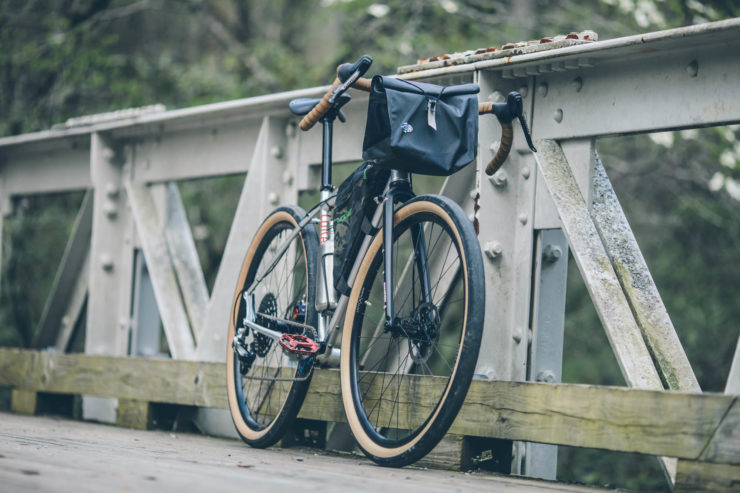
Wider Tires, Same Diameter
There are a few 700C drop-bar bikes that can fit big tires. Both the Salsa Cutthroat and the Kona Sutra LTD (though in marketing terms they’re drop-bar 29ers) can fit 29 x 2.3” tires via the use of a 72mm bottom bracket shell. And there are several others that can accommodate 45mm or larger rubber. But, much of the draw of 650B is that it enables the use of wide tires while maintaining a smaller and more manageable tire diameter. For reference, the diameter of a a 650B x 47mm tire equals that of a 700x28mm tire.
So, why should this matter? For many riders, the large diameter of a 700C x 45mm or 29 x 2.1” tire might feel too big. Not always, but sometimes. And, for many riders under 5 ½ feet tall, the smaller diameter of 650B might feel more comfortable. In addition, reducing the rim diameter allows a bike to maintain better handling characteristics and react more quickly to rider input. With that said, 650B works for taller riders as well.
If you are simply looking to swap tires on a bike, consider your bike’s geometry—the reason there used to be 700A, B, and C. If a bike was designed around 25mm tires and you manage to squeeze 2” rubber into the frame, there will be consequences. Most notably, in the bike’s standover height and toe overlap. Conversely, if a bike was designed around 700C x 45mm tires and you switch to 650B x 47mm, the bottom bracket will likely be far too low. This is why the diameter of a bike’s intended wheel and tire combo should be scrutinized. 650B tires, such as the popular 47mm Byway or 48mm Switchback Hill, will have a diameter of about 678-679mm, approximately the same as a 700C x 28mm wheel/tire combo. Here are five useful equivalents:
700C x 23mm = 668mm = 650B x 42mm 700C x 28mm = 678mm = 650B x 47mm 700C x 32mm = 686mm = 650B x 50mm 700C x 35mm = 692mm = 27.5 x 2.1” 700C x 38mm = 698mm = 27.5 x 2.25”
Generally speaking, the main reason folks are making the switch to 650B is to have wider tires, but that’s just one part of the equation. Consider these additional reasons…
Maintain a Comfy Gearing
Toe clearance, low overlap.
Toe overlap is a term for shoe interference from the front tire, usually experienced at slower speeds when pedaling technical terrain or during maneuvers that require tight turning. Most drop-bar bikes with bigger tires will have a little toe overlap, but there is definitely a point at which it can become a burden. That’s where 650B saves the day. With the same diameter as a 700C x 28mm tire, a 650B x 48mm tire can provide all the goods without risking excessive toe overlap.
Bonus Round: Hidden Perks
There are a few other inherent advantages to moving from 700C to 650B. For one, shorter spoke lengths make stronger wheels. By virtue, smaller wheels should be stiffer, too, which means more responsive pedaling. In addition, smaller rims and wheels mean less metal was used to make the rims and spokes, which should translate to a lighter wheel. Smaller wheels and tires free up more room for seat bags and handlebar bags too. And, last but not least, they make packing a bike easier for travel or shipping.
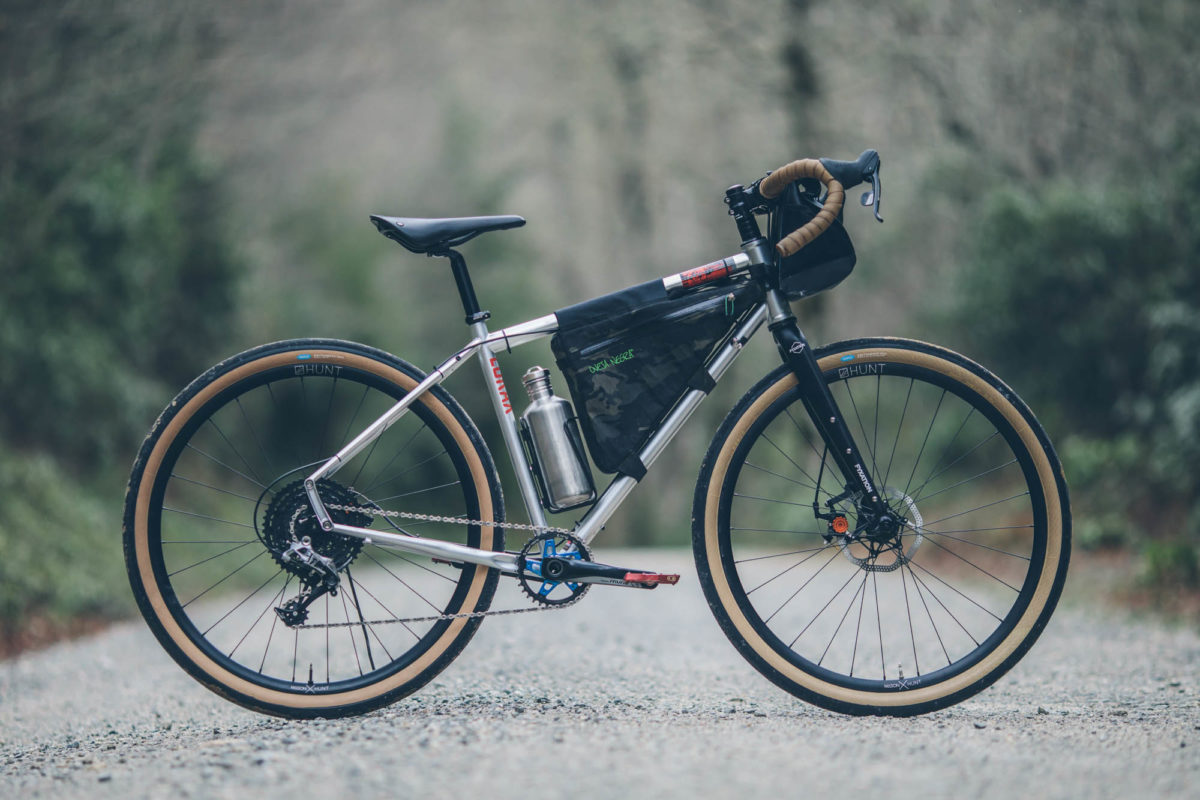
Converting a 700C Bike to 650B
Before the current trend of new 650B production drop-bar bikes, 650B was largely relegated to small frame builders, randonneuring enthusiasts, tinkerers, and folks interested in converting older road bikes to get some of the big tire secret sauce. In the following section, we’ll look at why the ideal 700C to 650B conversion involves a bike built around skinner 700C wheels that normally fit less than 40mm tires, like a touring or cyclocross frame. The most common and appropriate 650B conversions involve a 700C bike built around 25-30mm tires.
For this project, we used a size medium Advocate Lorax , a bike designed around 700C x 38mm tires, and an already adept gravel bike. But the Lorax maxes out at 40mm tires in 700C and more volume was needed. Even so, we knew going into it that this wasn’t the perfect bike for road plus tires, but it would work with shorter cranks. This leads us to the first factor to consider before tackling a 650B conversion: the bike’s intended tire size. As mentioned, 650B x 47/48mm tires usually have a similar diameter to a 700c x 28/30mm wheel/tire combo. If your bike was designed around such a tire, or a 32-35mm tire, 650B conversion might be appropriate. And, even if you have a bike designed around 700C x 35-42mm tires, it is still a possibility, but bottom bracket height and tire width clearance might be issues. Either way, there are a few preliminary details to evaluate:
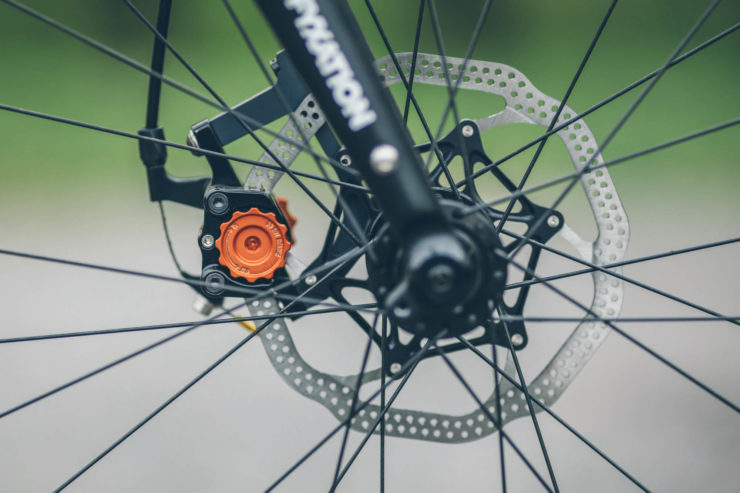
Disc Brakes
Brakes are most hardline obstacle when switching from 700C (622mm) to 650B (584mm) wheels. If your bike has disc brakes, you’re golden. If not, you’ll have to decide whether it’s worth the trouble. 650B rims have a radius that’s 19mm smaller than that of 700C. So, if you’re running non-disc brakes, you’ll need to have your brake mounts moved or find brake calipers with a really long reach. Just how long of a reach you’ll need – and whether you can even use your existing centermount or post mounts – will depend on the dimensions of your specific frame and fork. To establish the required brake reach, measure the reach with the original 700C wheels and add 19mm. There are rumors that it’s sometimes possible with BMX-style and centerpull calipers and, but that’s beyond the scope of this article.

Tire Clearance
If brakes aren’t an issue, the next most obvious consideration is whether or not your bike has the proper clearance for big 650B tires. The favorable 650B x 47/48mm tires, made popular by the 48mm Compass Switchback Hill and 47mm WTB Byway, have a similar tire diameter to 700×28 wheels and tires. So, chainstay length isn’t usually the issue. It’s the width that can be a challenge. The widest point in a 650B x 47-48mm tire is about 325mm from center of the rear axle. So if you measure that distance on your stay, from the rear axle, you should have over 58mm of room (in our opinion) for a 47/48mm 650B tire. The Lorax has 63mm, which left a comfortable 8mm on each side of the tire as breathing room.

Bottom Bracket Drop
Now that we’ve covered tire diameter, it’s easy to see how to match the intended vertical stance of a bike. But, what about the actual numbers? What makes a BB height short enough that pedal strikes and cornering will be an issue? To answer that, let’s look at the bottom bracket drop (distance of center of BB shell from axle plane) on a few recently released 650B-specific bikes. The Bombtrack Audax has a 65mm BB drop (L), Surly’s Midnight Special shows 65mm, Chumba’s Terlingua has about 66mm, and the Masi Speciale Randonneur 650B has 70mm. All four are specced with 47mm WTB Byways. Moving to the MTB side of the spectrum, the Norco Search XR (70mm BB drop), the Salsa Journeyman (72mm), and the large Bombtrack Hook EXT-C (67mm) are all specced with 27.5 x 2.1” tires.
One thing to remember with wider tires is that they have more tire drop—more deflection under load. According to Jan Heine, “You really need to factor the BB height with about 15% tire drop. In the old days, with 20mm tires, tire drop was 3mm—not a big deal—but the Switchback Hill 48mm tire will drop about 7mm when the rider is on the bike!” Jan also suggested that tire drop is independent of rider weight, and that for this type of tire, it’s appropriate for air pressure to be set at about 15% tire drop, almost like suspension sag. Heavier riders use higher pressure, lighter riders lower pressure.
Now, what’s the proper BB drop for 47-48mm road plus tires? Between 63 and 70mm, it seems. According to Jan, “For a 650B x 48mm Switchback Hill, you’ll need a 70mm bottom bracket drop to achieve the ‘road standard’ BB height of 265mm. With a 650B x 42mm tires, you’ll want a bit less BB drop—ideal would be 63mm.” The Lorax has a 75mm BB drop, which is a little low. But with 170mm cranks it seems OK after a few rides. we may end up putting 50mm tires on it to beef it up a hair though.
And for 2.1-2.2” MTB tires? 65-75mm. Anything lower might start being risky when it comes to pedal clearance. Of course, some of this can be mitigated with shorter cranks, such as 165 or 170mm arms. Your preferences may differ depending on intended terrain. I personally think between 65-67mm is ideal, with 170mm crank arms, as this provides adequate clearance for riding on some extra chunky bits.
Another reference is WTB’s list of compatible frames that will work with their Byway road plus tires. However, this is by no means a complete list.
The Cast of Components
Given its modular dropout system, the Advocate Lorax is a versatile bike to tinker with for a project such as this. Switching the modular dropouts from a 135mm/QR to a 142 x 12mm thru-axle enabled a stiffer and modernized rear end. We handpicked all the components to create a 650B bike specifically for gravel bikepacking. Here they are:
Hunt AdventureSport Disc
Hunt has a lot of great wheels in tons of widths and configurations, all very reasonably priced and designed to withstand adventure. The AdventureSport Disc, as used here, are a good option for 42-48mm tires. They feature a 20mm inner width, tubeless ready rim with a hookless bead, and an asymmetric spoke design for toughness and durability. In addition, they are extremely versatile. Each wheelset includes axle adapters to convert to QR or thru-bolt in 12/15/9mm axle diameters (front), and 12×142, 12×135, 10×135 in the rear. They also include tubeless tape and valves, spare spokes, and a spoke key, all for about $445 USD. Hunt also has wider wheelsets that might be a little better for 48-2.2” tires. Check out their 24mm IW AdventureCarbon wheels, affordable 29mm IW TrailWide, and their Dynamo specific wheels.
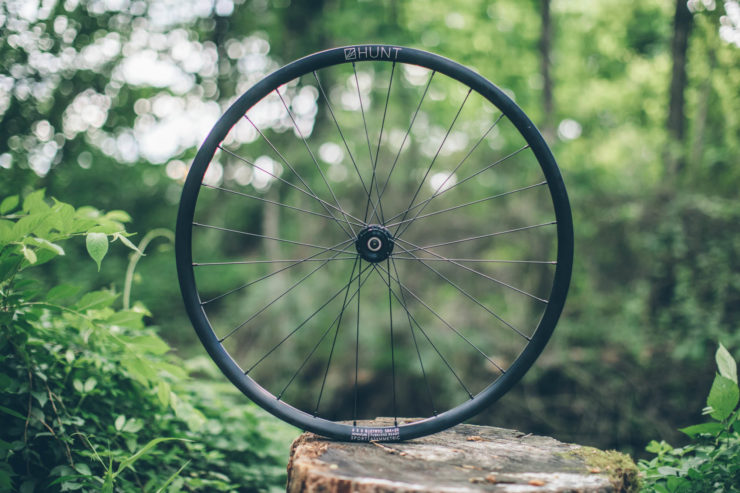
SRAM Rival Drivetrain
In our opinion, SRAM Rival is the best bang for the buck when it comes to modern road drivetrains. It’s versatile, and you can usually get a Rival 1 shifter/derailleur/crankset for a little over $300. The derailleur and shifter are extremely solid, and it gives you a lot of options. For starters, the Rival 1 (1x) is a direct mount crankset, so you can easily switch the chainring to dial in gearing.
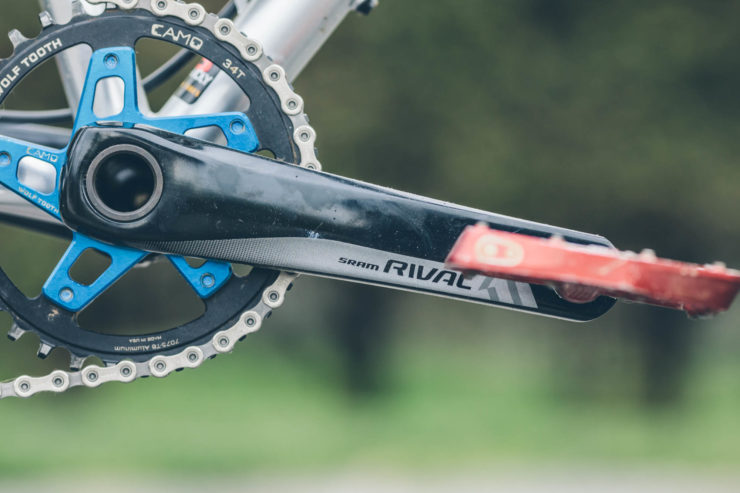
We added a Wolf Tooth CAMO system to facilitate easily swapping out chainrings for different rides. And, the Rival 22 (2x) offers a decent 50/32 ring combo, although 46/30 would be a little better for loaded bikepacking. In addition, the XG-1150 full-pin steel cassette is super solid. And, if a 42T big cog isn’t enough, the Rival derailleur also works with a 46T cassette.
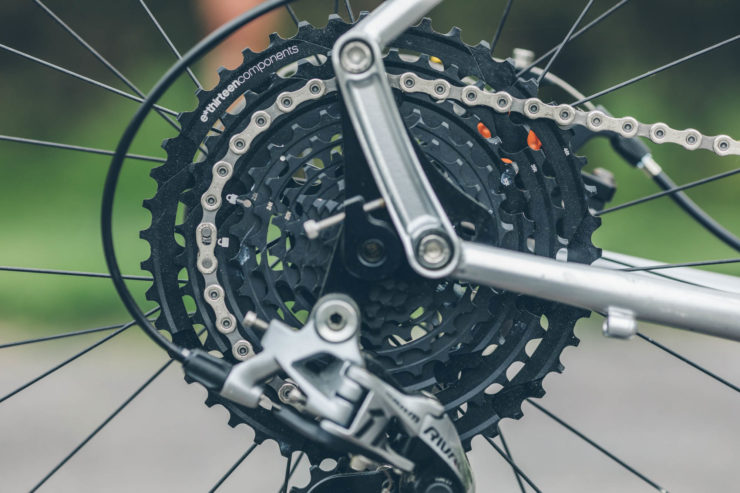
eThirteen TRSr Cassette
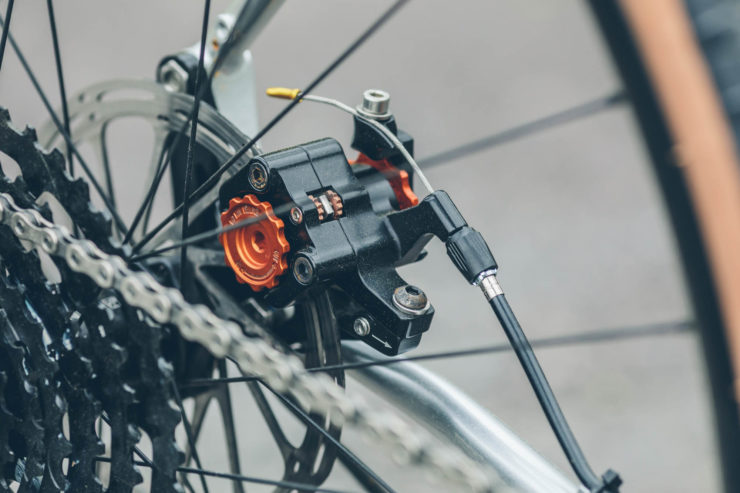
PAUL Klamper Brakes
BB7s aren’t the only mechanical disc brakes on the market. After using the Paul Klamper on trips through Uganda, Rwanda, the US, and, recently, the Republic of Georgia, we are pretty confident in their durability. And, aside from their stylish design, adjustments on the Klamper are the easiest of all the mechanical disc brakes we’ve tried. Plus, they’re made in Chico, California, by a great company. We got a pair of short-pull black and orange versions for this build.
Fyxation Sparta All Road Fork
There are a few carbon replacement forks out there now, but the Fyxation Sparta is available at the right price and with all the right features. The bottle mounts are a big selling point, but it also has the right measurements—400mm axle to crown, 45mm rake, and options for 100 x 12 or 15mm bolt-in thru-axles. The Sparta also has provisions for fender mounts, internal cable routing, and room for 650b x 50 road plus tires. For $299, it seems like a great choice for a gravel bike fork. It’s stiff and does a good job soaking up the chatter, too.
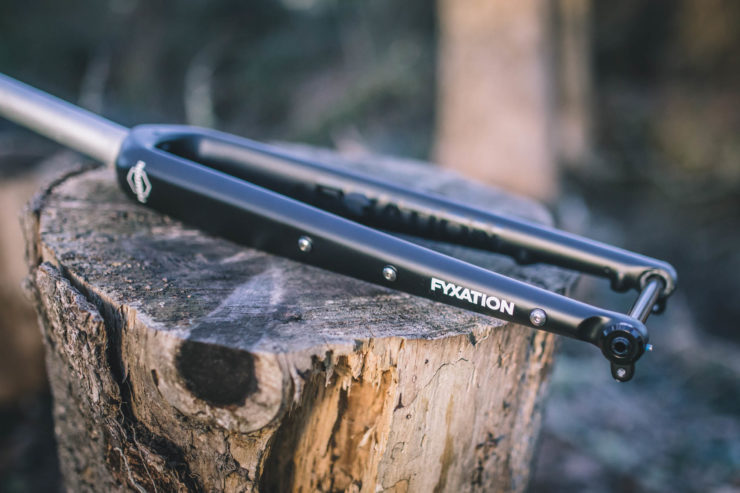
Other impressive bits and bobs include a Brooks Cambium C17 All Weather saddle, Brooks Cambium bar tape, PAUL BoxCar stem, PAUL Tall and Handsome seatpost, and Salsa Cowchipper handlebars. Here’s the full build kit:
- Frame Advocate Lorax (M)
- Fork Fyxation Sparta All-road
- Shifter/Derailleur SRAM Rival 1
- Crankset Rival 1 38T
- Cassette eThirteen TRSr 9-46
- Rims Mason x Hunt AdventureSport 24mm deep | 25mm wide (external)
- Hubs Mason x Hunt 4Season Disc (142 x 12mm r / 100 x 15mm F)
- Brakes PAUL Klamper (short pull)
- Handlebars Salsa Cowchipper 144cm
- Bar Tape Brooks Cambium Rubber (Natural)
- Stem PAUL Boxcar 50mm
- Seatpost PAUL Tall & Handsome
- Saddle Brooks C17 All Weather Carved Black
- Tires WTB Byway / Compass Switchback Hill

Have something to add about your own experience converting from 700C to 650B? Leave a comment below. Also, stay tuned for more coverage on the Compass Switchback Hill and WTB Byway tires.
FILED IN (CATEGORIES & TAGS)
Bikepacking gear.
Please keep the conversation civil, constructive, and inclusive, or your comment will be removed.
Rad Companies that Support Bikepacking

You need to be logged in to use these features. Click here to login , or start an account if you’re not yet a member of the Bikepacking Collective…
Enjoying Our In-Depth Reviews?
As a small, independent publication, we take pride in creating honest and comprehensive gear reviews, guides, and more. But, as a community-supported platform, we need your help. The high-quality reporting, news, and original bikepacking routes we’ve been sharing for more than a decade are made possible by our members. With our fall member support drive deadline approaching*, please consider joining the Bikepacking Collective today to help us continue making content like this.
Already a member? Thanks for your support! Login to hide this message *Join by October 17th and start your membership with Issue 13 of The Bikepacking Journal
April 10, 2010
Trek 650b conversion: built..
2 comments:
How is the handling? I had a Rockhopper converted to 650b and it was fine offroad, especially with a 26" rear tire. I prefer commuting on 26" slicks though. 650b is a just too slow handling.
got an update on this set up? Hope all is well and look forward to seeing the next 650b palace update soon. :)
Post a Comment
Ocean Air Cycles – Click to Shop
Bicycles and Gear for Going Places Near and Far Self Propelled With Comfort and Speed
Trek 613 650b Conversion For Sale
The Trek 613 650b conversion I did for a customer just over two years ago has come back to our stable to find a new home. It has aged quite gracefully, and looks better now then it did at the start.
The Trek 613 frame is the backbone for this build. it was what Trek listed as a 23″ frame, and has a 57cm seat tube and a 56cm top tube, It would best first riders with a pubic bone height in the mid 80’s
Everything about this build/restoration met or exceeded the original expectations. There were a few things that worked but need disclosure. The extra long reach brakes stop the bike, but will not induce a skid. This is not really a safety issue but sometimes the nature of these sort of conversions, the bike stops just fine when you need it to. There are some chips and scratches in the paint, no dents. The Suntour Symmetric shifter is gorgeous, but only pulls enough cable to shift through 7 of the 8 rear cogs. The stainless Berthoud fenders have a few small dents, but are solid and crack free. The HT AE-01 pedals are in need of a rebuild, they spin fine, but a rebuild would get you another decade out of them. The original front rack and basket were intended to be a temporary thing, that ended up going the whole time. I was not happy with the mounting and they are not included with this offering. I would recommend the Soma Porteur or Pass & Stowe as the best non-custom replacement option.
On the plus side this is an incredibly smooth and nimble riding bike. Everything is in fine working order to take it home and get riding. It has proven itself both around town and on more then a few mixed terrain short tours. The Brooks B17 Select has restored my faith in current Brooks production standards. There are a few top notch upgrades like the Nitto Technomic stem and Albatross bars, and Brooks Select saddle. The serial Numbe r, dates the bike to 80-81 an fit is in fantastic condition for a bike that age. It is rust free inside and out. All of the bearings are clean and free spinning.
I am offering the bike at $1800 $1500 as seen in the pictures. I have a couple of interested parties, but I am starting a list of potential buyers. While I would prefer a local sale, we can facilitate packing and shipping at a reasonable fee. If the potential buyer would like too use this as a starting point for some other improvements, I would be willing to facilitate any thing you may want, like a new front rack etc. Contact me for a full re-build quote
General thoughts, Trek 650b conversions like this are intended to be ridden with a front load. The handling is great unloaded, but things really stay nice and neutral as you put a but up front. The big difference between this and the Ramblers is all of the details for lighting, better performing brakes and rack mounts. These old Treks provides a fair amount of inspiration for the Ramblers.
Leave a Reply Cancel reply
Your email address will not be published. Required fields are marked *

IMAGES
VIDEO
COMMENTS
Trek 613 650b Conversion Complete. This is the most beautiful bike I have built up yet. I would even go as far as saying it is nicer than my roadeo from Rivendell. After years of reading on the web and doing multiple 650b conversions on my own, this one went together perfectly the first time.
Those of us who have undertaken 650B conversions understand the brake reach, tire clearance and other considerations that must be explored when contemplating whether to convert a bike to 650B. My spammer, however, believes that one can alter the geometry of a frame by changing the wheel size.
The best 650B conversion bicycles will accommodate a range of tires from 32mm to 38mm wide. Your frame will need clearance for these bigger tires. The widest part of a 650x38B tire is located 320mm from the axle center.
The creator of 'The Frek', Steve Frey, builds his 8th 1982' Trek 614 - 650b conversion. Steve built his original Frek years ago and it was covered in the winter 2016 Bicycle Quarterly...
650b Conversion - Trek 613b (1982) 740 views. Joseph Kopera. Aug 10, 2016, 9:18:00 PM. to 650b. Hi All, Finally finished converting an old 1982 Trek 613B frame to 650b-- a project I...
Interested in a 700C to 650B conversion to transform your cross or road bike into a gravel bikepacking rig? How about 650B/road plus? Here's our guide...
Trek 650B Conversion: Built. I've finally finished the Trek 930 conversion. I've given the bike limited saddle time, but it was never intended to be a main bike. I basically tossed it together with a few extra parts, and a few new ones.
There are a few top notch upgrades like the Nitto Technomic stem and Albatross bars, and Brooks Select saddle. The serial Numbe r, dates the bike to 80-81 an fit is in fantastic condition for a bike that age. It is rust free inside and out. All of the bearings are clean and free spinning.
I just converted a Centurion road frame to 650b. It had room for the same size tires, 650b x 1.75. I went cheap and got Paselas, which I like just fine. The outer diameter ended up about the same as the 700×32's that were on it, so the handling didn't change much, there's just a lot more shock absorption from the extra air.
The creator of 'The Frek', Steve Frey, builds his 8th 1982' Trek 614 - 650b conversion.